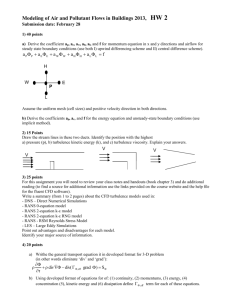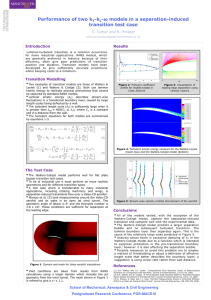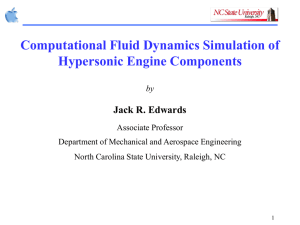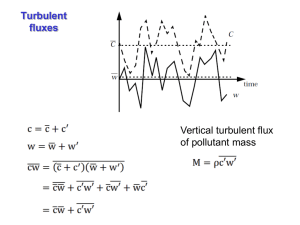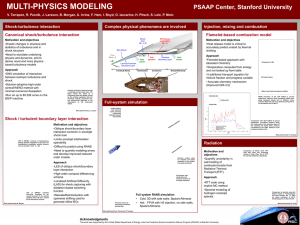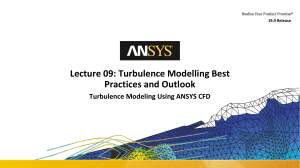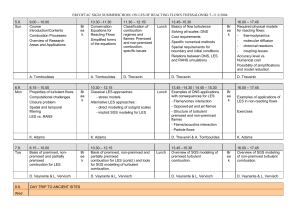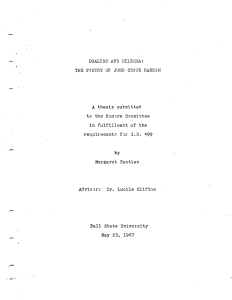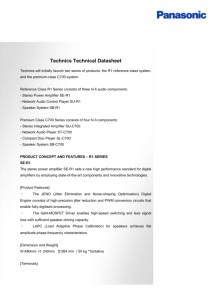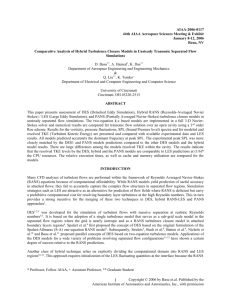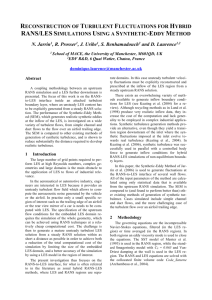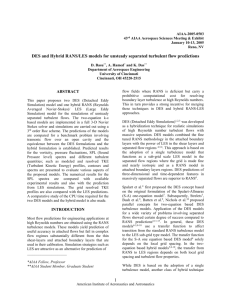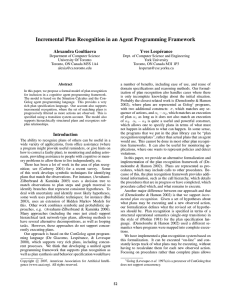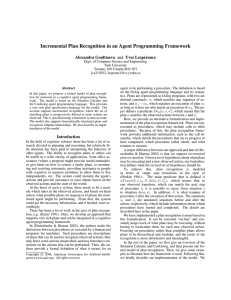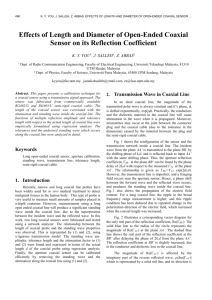yacine-thmt
advertisement
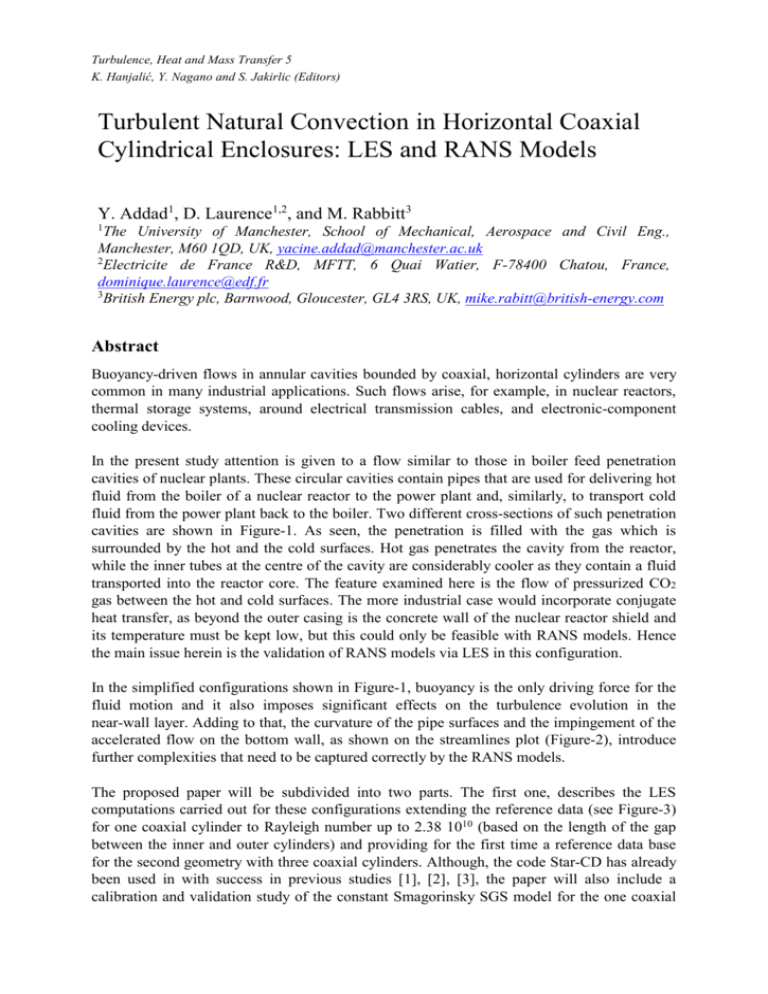
Turbulence, Heat and Mass Transfer 5 K. Hanjalić, Y. Nagano and S. Jakirlic (Editors) Turbulent Natural Convection in Horizontal Coaxial Cylindrical Enclosures: LES and RANS Models Y. Addad1, D. Laurence1,2, and M. Rabbitt3 1 The University of Manchester, School of Mechanical, Aerospace and Civil Eng., Manchester, M60 1QD, UK, yacine.addad@manchester.ac.uk 2 Electricite de France R&D, MFTT, 6 Quai Watier, F-78400 Chatou, France, dominique.laurence@edf.fr 3 British Energy plc, Barnwood, Gloucester, GL4 3RS, UK, mike.rabitt@british-energy.com Abstract Buoyancy-driven flows in annular cavities bounded by coaxial, horizontal cylinders are very common in many industrial applications. Such flows arise, for example, in nuclear reactors, thermal storage systems, around electrical transmission cables, and electronic-component cooling devices. In the present study attention is given to a flow similar to those in boiler feed penetration cavities of nuclear plants. These circular cavities contain pipes that are used for delivering hot fluid from the boiler of a nuclear reactor to the power plant and, similarly, to transport cold fluid from the power plant back to the boiler. Two different cross-sections of such penetration cavities are shown in Figure-1. As seen, the penetration is filled with the gas which is surrounded by the hot and the cold surfaces. Hot gas penetrates the cavity from the reactor, while the inner tubes at the centre of the cavity are considerably cooler as they contain a fluid transported into the reactor core. The feature examined here is the flow of pressurized CO2 gas between the hot and cold surfaces. The more industrial case would incorporate conjugate heat transfer, as beyond the outer casing is the concrete wall of the nuclear reactor shield and its temperature must be kept low, but this could only be feasible with RANS models. Hence the main issue herein is the validation of RANS models via LES in this configuration. In the simplified configurations shown in Figure-1, buoyancy is the only driving force for the fluid motion and it also imposes significant effects on the turbulence evolution in the near-wall layer. Adding to that, the curvature of the pipe surfaces and the impingement of the accelerated flow on the bottom wall, as shown on the streamlines plot (Figure-2), introduce further complexities that need to be captured correctly by the RANS models. The proposed paper will be subdivided into two parts. The first one, describes the LES computations carried out for these configurations extending the reference data (see Figure-3) for one coaxial cylinder to Rayleigh number up to 2.38 1010 (based on the length of the gap between the inner and outer cylinders) and providing for the first time a reference data base for the second geometry with three coaxial cylinders. Although, the code Star-CD has already been used in with success in previous studies [1], [2], [3], the paper will also include a calibration and validation study of the constant Smagorinsky SGS model for the one coaxial Turbulence, Heat and Mass Transfer 5 cylinder type of geometry using the experimental data of McLeod et al [4] at a lower Rayleigh number of 1.18·109. In the second part, a comparison will be made between different RANS models ranging from k-e linear and non-linear models, k- and SST k- models, to second-moment closures to illustrate their ability to predict the correct flow features in such flows. For example, the grid independency tests carried out with a low Reynolds k- model of the low Rayleigh number test case (see Figure-4) show the classical trend of the model to over-predict the turbulent energy at the impingement location (angle 0o) but in general the model predictions are in fairly good agreement with the reference data. On the other hand, for the second geometry with three coaxial cylinders, this model along with the other two-equations based models are observed to fail dramatically in predicting the correct trend of the flow (see Figure-5). Therefore, the extension to the more elaborate RSM type of models seems inevitable. References [1] [2] [3] [4] Addad Y., Benhamadouche S., Laurence D., 2004, “The Negatively Buoyant Turbulent Wall Jet: LES Results”, Int. J. Heat and Fluid Flow, Vol. 25, 5, 595-808. Addad Y., Laurence D., Talotte C. and Jacob M. C., 2003, “Large Eddy Simulation of a Forward-Backward Facing Step for Acoustic Source Identification”, Int. J. of Heat and Fluid Flow, Vol. 24, 4, 562-571. Y. Addad 2005 “Large Eddy Simulations of Bluff Body, Mixed and Natural Convection Turbulent Flows with Unstructured FV Codes” PhD thesis, Department of Mechanical, Aerospace and Manufacturing Engineering, UMIST. McLeod E. A., Bishop E. H., 1989, “Turbulent Natural Convection of Gases in Horizontal Cylindrical Annuli at Cryogenic Temperatures”, Int. J. Heat and Mass Transfer, Vol. 32, 10, 1967-1978. Cold wall 65 C 0 o 90o Hot wall 300 C Figure 1. A schematic sketch of the annular cavities considered in the present study. K. Hanjalic et al. T 299 279.5 260 240.5 221 201.5 182 162.5 143 123.5 104 84.5 65 0.15 0.15 0.1 0.1 0.05 0 Y Y 0.05 0 -0.05 -0.05 -0.1 -0.1 -0.15 -0.15 -0.15 -0.15 -0.1 -0.05 0 0.05 0.1 0.15 -0.1 -0.05 0 0.05 0.1 0.15 X X Figure 2. Plots of streamlines superimposed on temperature variation. Figure-3 The mean Nusselt numbers versus Rayleigh number Figure-4. Comparison of LES results with Exp. Data [5] at Ra=1.18 109, as well as Low-Re. RANS model predictions. Turbulence, Heat and Mass Transfer 5 Figure-5 Predictions of the RANS models for the annular cavity case with three coaxial cylinders. Left: flow predictions with k-e model, right: flow predictions with RSM model.
